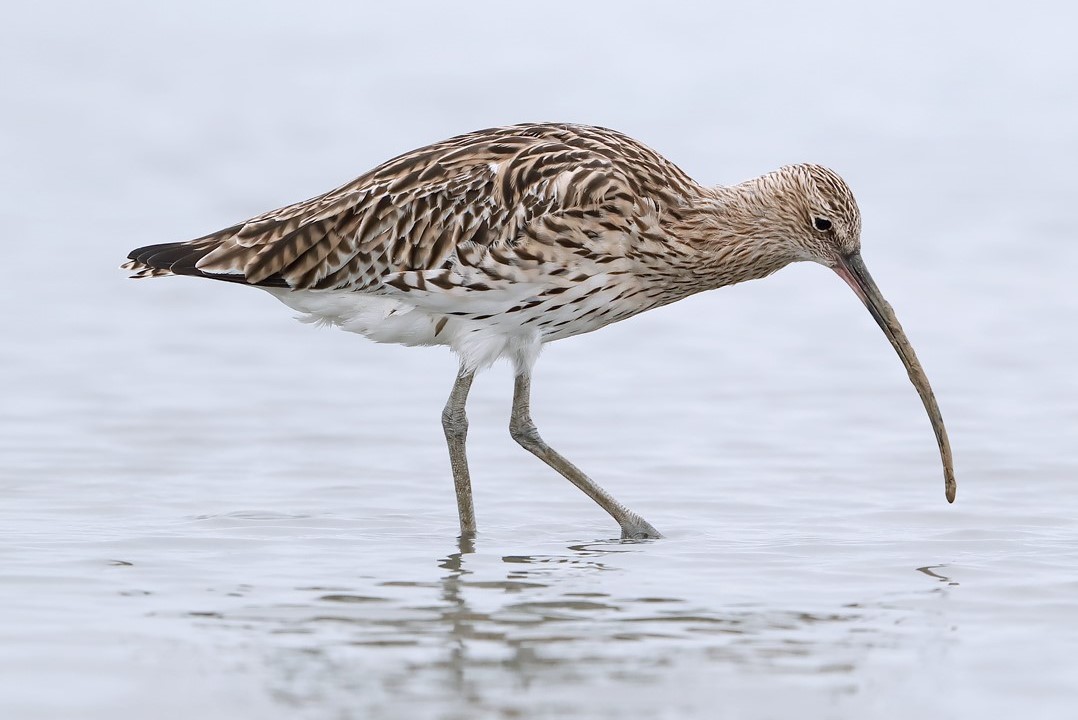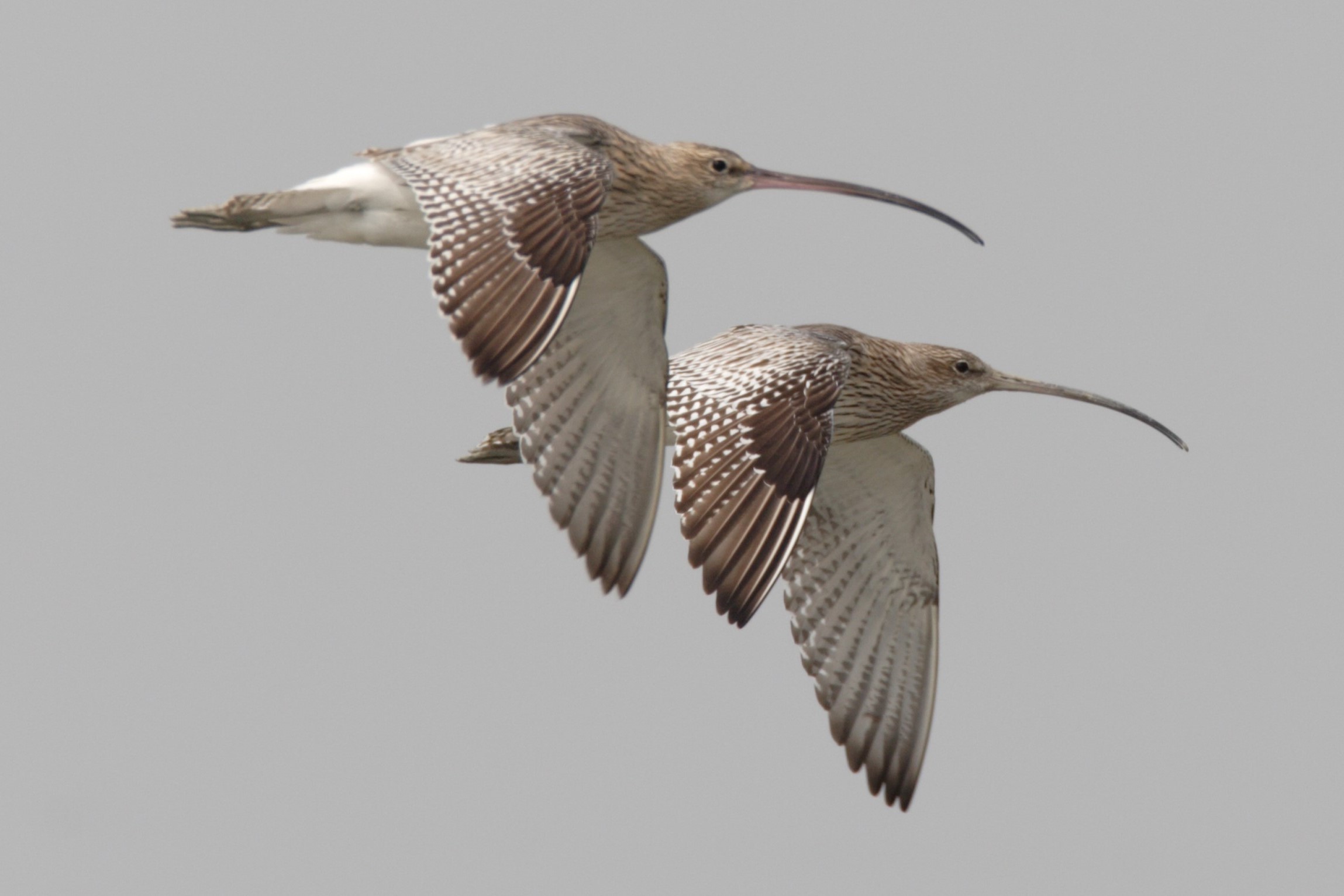Eurasian Curlew Numenius arquata 白腰杓鷸
Category I. Abundant winter visitor and uncommon passage migrant and summer visitor to the Deep Bay area.
IDENTIFICATION

Feb. 2018, Michelle and Peter Wong. Male.
50-60 cm. Very large shorebird with long decurved bill (longer in female), rather uniform brown plumage with extensive dark bars and streaks. The commonest of the two curlews at all times of year. Length of bill indicates bird illustrated is probably a male.

Oct. 2004, John and Jemi Holmes.
In flight white rump extends up lower back and has largely white underwing coverts, which indicate orientalis subspecies.
VOCALISATIONS
Vocalisations are generally loud and ringing. The two most often heard calls are a two or three-note ‘tyoo-tyoo(-tyoo)’ and a ‘kooolee’ rising on the final note.
At high tide roost a guttural conversational call is frequently heard, often terminating in an inflected higher-pitched note.
DISTRIBUTION & HABITAT PREFERENCE
Most records are from the intertidal mudflats of Deep Bay and adjacent roosting areas, primarily Mai Po NR. Small numbers are rarely recorded at other intertidal mudflat areas, the most significant being 56 (the highest count away from Deep Bay) at Starling Inlet on 8 September 1997 and up to 16 birds at Shuen Wan for a month from 22 January 2003. There are no modern records from commercial fish ponds and only one from Long Valley.
Records elsewhere mainly comprise up to 40 birds on migration over southern waters, mostly in spring from 24 March to 16 May, but also in autumn from 26 August to 12 September. There are only three records from the grassy areas of the former and present airports at Kai Tak and Chek Lap Kok respectively. Nocturnal migration has been recorded over Waglan Island and Sai Kung from 20 August to 7 October.
OCCURRENCE
Eurasian Curlew can be seen throughout the year in the Deep Bay intertidal area and adjacent roost sites, though it is primarily a winter visitor and occurs in very low numbers at other times.
The first autumn arrivals probably occur during the last ten days of July. As Figure 1 indicates there is a weak passage that peaks in September. The main influx of wintering birds occurs during the second half of November and early December.
The numbers recorded have gradually increased since the mid-1980s when access to Deep Bay intertidal area improved. Most counts since winter 2004/05 have been over 1,000, whereas only two peak winter waterbird counts were that high previously. The highest count is 1602 on 16 January 2011 (Figure 2). Based on winter waterbird counts in Deep Bay Sung et al. (2021) concluded that the wintering population increased from 1998 to 2017. It is noticeable that many of the highest counts have occurred in late January and February, possibly indicating return passage. Eurasian Curlew is an early migrant elsewhere in its range (Cramp and Simmons 1983).
Generally, numbers during April are very low, though occasionally an influx occurs at the end of the month or early May when counts of up to 90 have been made. Usually, 30 or fewer birds remain during summer, with 40 being the highest count.
Vaughan and Jones (1913) described Eurasian Curlew as a common winter visitor to southeast China arriving as early as 3 September and leaving by 3 March. This was not the experience of Dove and Goodhart (1955), however, who only had two records at the end of December. Macfarlane and Macdonald (1966) noted that fewer were seen in spring than autumn and stated that they had been seen almost throughout the year.
BEHAVIOUR, FORAGING & DIET
Appears to feed almost exclusively on the intertidal mudflats where it has been noted taking crustaceans, molluscs and annelids. Gregarious, especially at high tide and when roosting. Leaves the mudflats late and prefers to remain if the high tide water level allows.
RANGE & SYSTEMATICS
Breeds from northwest Europe east across northern and central Europe through western Russia and northern Kazakhstan to northeast China, barely extending into northern Mongolia and Ussuriland. Winters largely coastally in Africa, the Middle East, the Indian subcontinent, Indonesia and south China (Van Gils et al. 2020). In China a summer visitor to the northeast and a winter visitor to the southern half of the country (Liu and Chen 2020).
Three subspecies are recognised of which the most likely to occur is N. a. orientalis breeding from west Siberia to Manchuria; N. a. suschkini breeds from west Kazakhstan to southwest Siberia, while nominate arquata breeds in Europe.
CONSERVATION STATUS
IUCN: Near-threatened. Population trend decreasing. Declines have been recorded in several populations and a moderately rapid global decline is estimated.
Figure 1.

Figure 2.

Cramp, S. and K. E. L. Simmons (eds) (1983). The Birds of the Western Palearctic. Vol. III. Oxford University Press, Oxford.
Dove, R. S. and H. J. Goodhart (1955). Field observations from the Colony of Hong Kong. Ibis 97: 311-340.
Liu, Y. and Y. H. Chen (eds) (2020). The CNG Field Guide to the Birds of China (in Chinese). Hunan Science and Technology Publication House, Changsha.
Macfarlane, A. M. and A. D. Macdonald, revised by Caunter, J. R. L. and A. M. Macfarlane (1966). An Annotated Check-list of the Birds of Hong Kong. Hong Kong Bird Watching Society, Hong Kong.
Sung, Y. H., C. C. Pang, T. C. H. Li, P. P. Y. Wong and Y. Y. Yu (2021). Ecological Correlates of 20-Year Population Trends of Wintering Waterbirds in Deep Bay, South China. Frontiers in Ecology and Evolution. Published 20 April 2021 doi: 10.3389/fevo.2021.658084
Van Gils, J., P. Wiersma, G. M. Kirwan, and C. J. Sharpe (2020). Eurasian Curlew (Numenius arquata), version 1.0. In Birds of the World (J. del Hoyo, A. Elliott, J. Sargatal, D. A. Christie, and E. de Juana, Editors). Cornell Lab of Ornithology, Ithaca, NY, USA. https://doi.org/10.2173/bow.eurcur.01
Vaughan, R. E. and K. H. Jones (1913). The birds of Hong Kong, Macao and the West River or Si Kiang in South-East China, with special reference to their nidification and seasonal movements. Ibis 1913: 17-76, 163-201, 351-384.

